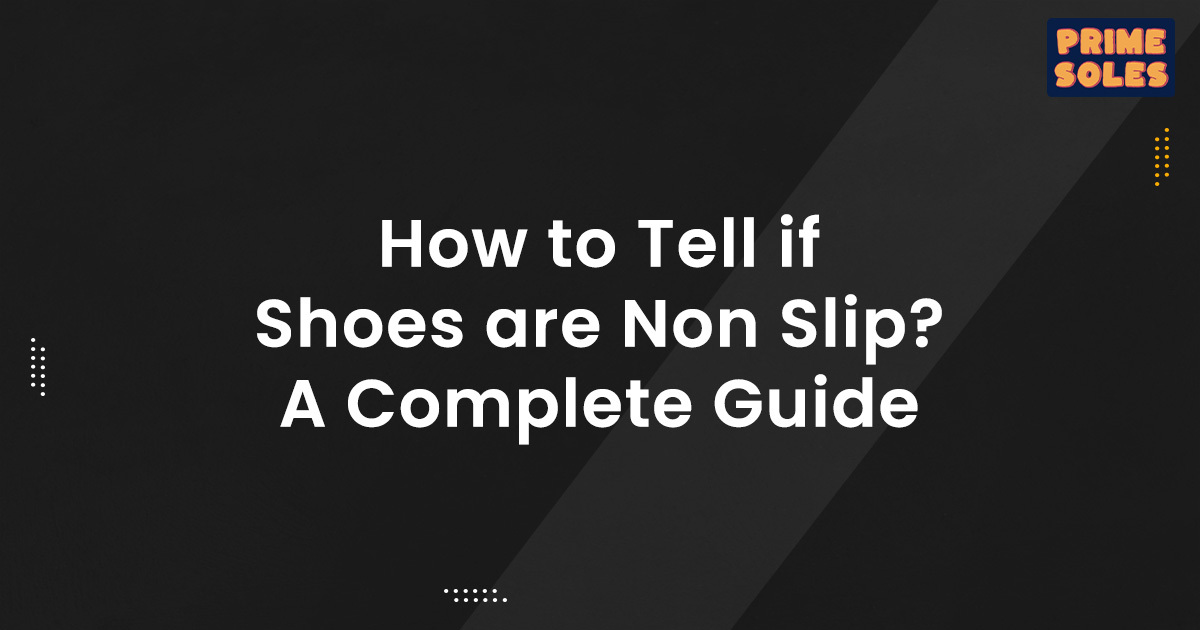Are you a sneaker lover who loves taking time off to explore? If so, then you know that finding the right shoes is essential. Non-slip shoes prevent slips and falls and provide excellent traction on unforgiving terrain. So how do you tell if your shoes are non-slip? In this blog post, we’ll explore the critical features of non-slip sneakers and provide tips on ensuring that your next shoe purchase is up to snuff regarding grip and protection. Prepare yourself with this must-have knowledge, and make sure your feet stay safe no matter where life takes you!

How to Tell If Shoes are Non Slip?
You must check a couple of things, whether the shoes are slippery or not. Let’s discuss these things.
Scrutinize the Tread Patterns
Begin by examining the tread patterns of the shoe. A shallow pattern may offer increased grip on wet or slippery surfaces, reducing stability and balance. Choose shoes with superior tread patterns, as they provide enhanced traction and stability across various terrains, ensuring a safer and more secure footing.

Check the Sole Material
Give attention to the material utilized in crafting the shoe’s sole, as it plays a crucial role in preventing slips and falls. Shoes with rubber soles are often commendable, offering robust gripping power on slippery surfaces. Prioritize checking the sole material of a shoe before making a purchase to ensure it aligns with your need for solid traction and enhanced slip resistance.

Look for Slip-Resistant Technology
Many brands have started using slip-resistant technologies in their shoes, like waffled or contoured outsoles. These technologies provide better traction and grip on slippery surfaces. It’s a good idea to look for these technologies in the shoes you buy.
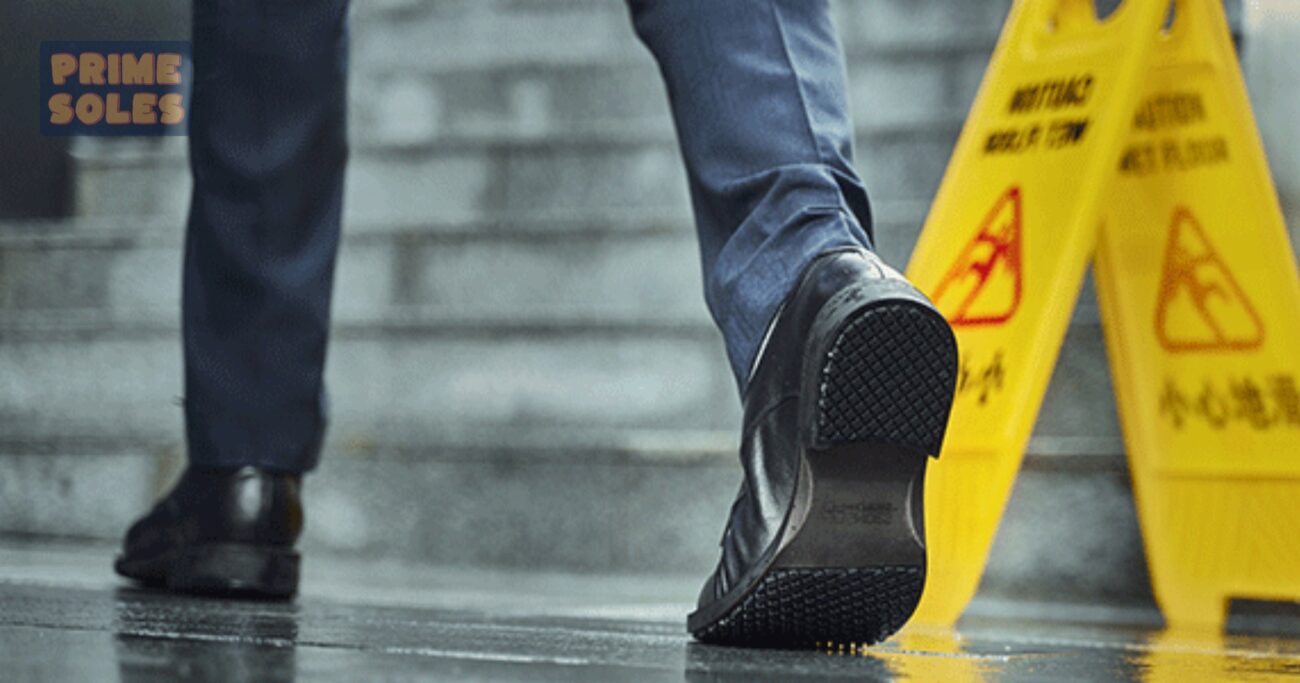
Check the Rounded Soles instead of the Flat Soles.
A rounded sole is more perfect for shoes than a flat or straight sole. If you are an athletic person who likes to wearing slip resistant shoes, check out the rounded soles on the athletic shoes in your closet. Rounded soles provide superior traction and joint support compared to flat shoe soles, which reduces injuries and increases athletic performance. On the other hand, flat-soled shoes are more comfortable for all-day wear but lack cushioning stability and support that come with athletic footwear designed with sole, rounded construction. Ultimately, if you want to stay safe while being active or walk around all day without discomfort, check out athletic shoes with a rounded soles and have them become your new partner-in-crime when staying active.

Rubber soles are always more slip-resistant than leather soles.
Rubber soles are a popular choice when it comes to anti-slip shoes. Compared to leather, rubber offers superior anti-slip qualities, making it a preferred option for those looking to ensure extra stability with each step. The surface of rubber soles provides increased resistance, making them difficult to slip on wet and greasy surfaces. They also provide optimal grip on dry surfaces, making them ideal for any terrain. Whether you’re planning a walk in the park or need to stand for long periods at work, investing in shoes with rubber soles could save you both from possible embarrassment and injuries.

Look for Grooves
Suppose you are looking for some durable material. Choose shoes with durable EVA rubber outsoles for a dependable running buddy that can navigate through wet or slippery surfaces without sacrificing comfort and grip. It’s time to fall in love with your shoes all over again by looking for grooved shoes that give you more stability and control, no matter where your feet take you!

Feel the Bottom
The bottom of the shoe is the central part of your shoe. Because if the material of the bottom of the shoe is not good or made of some leather stuff, then maybe the grip of your shoe is not well. So, it’s essential to find a perfect slip-resistant shoe. A good portion of safety support and success in any training is to feel the bottom of your shoe to ensure that perfect hold on the slippery surface. With a perfect grip on each step, your confidence increases and gives you the advantage to perform at your best. So get out there and feel the bottom of your shoe for perfect slip-resistant wear!
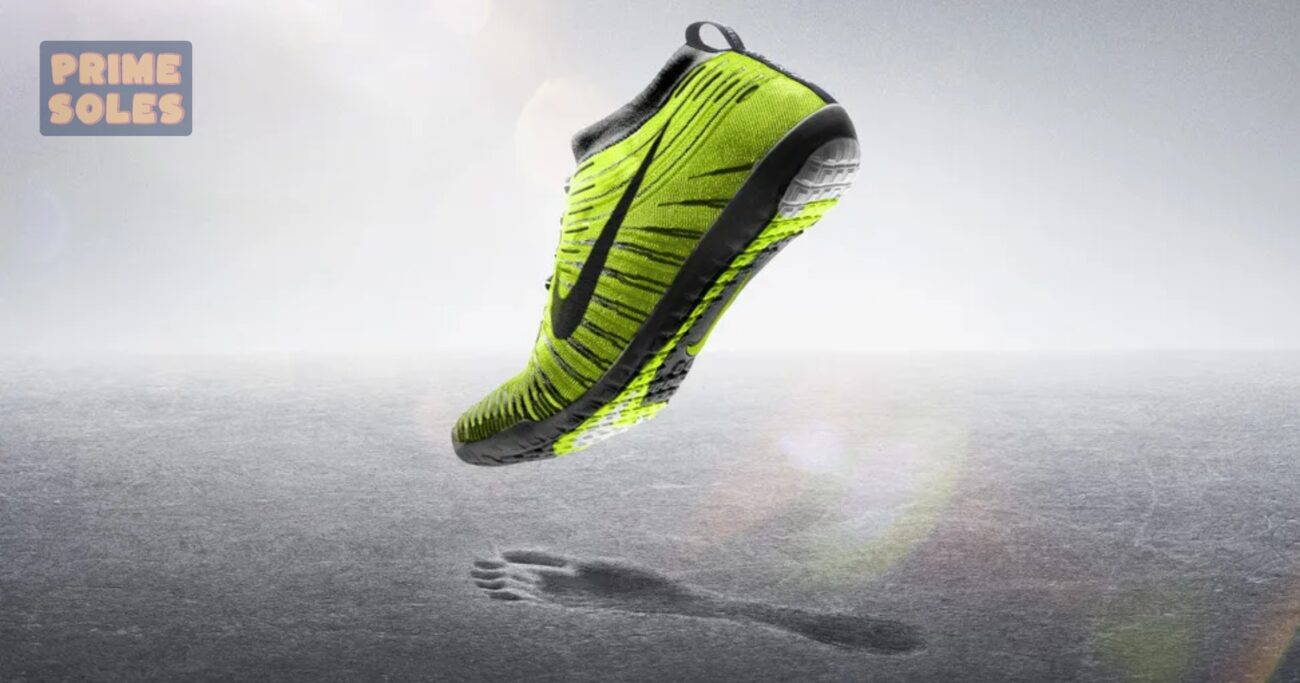
What makes shoe slip-resistant?
Do you want to make your shoe slip-resistant? We will give you some ideas that will help you to make your shoe slippery-resistant.
Patterns
The pattern of your shoes can have a significant impact on slip resistance. Shoes with a wide, flat sole offer more stability, while deeper grooves provide extra grip and traction. When shopping for non-slip shoes, look for styles that feature textured or bumpy patterns on the outsole. This will give you a better grip and protection on slippery surfaces.
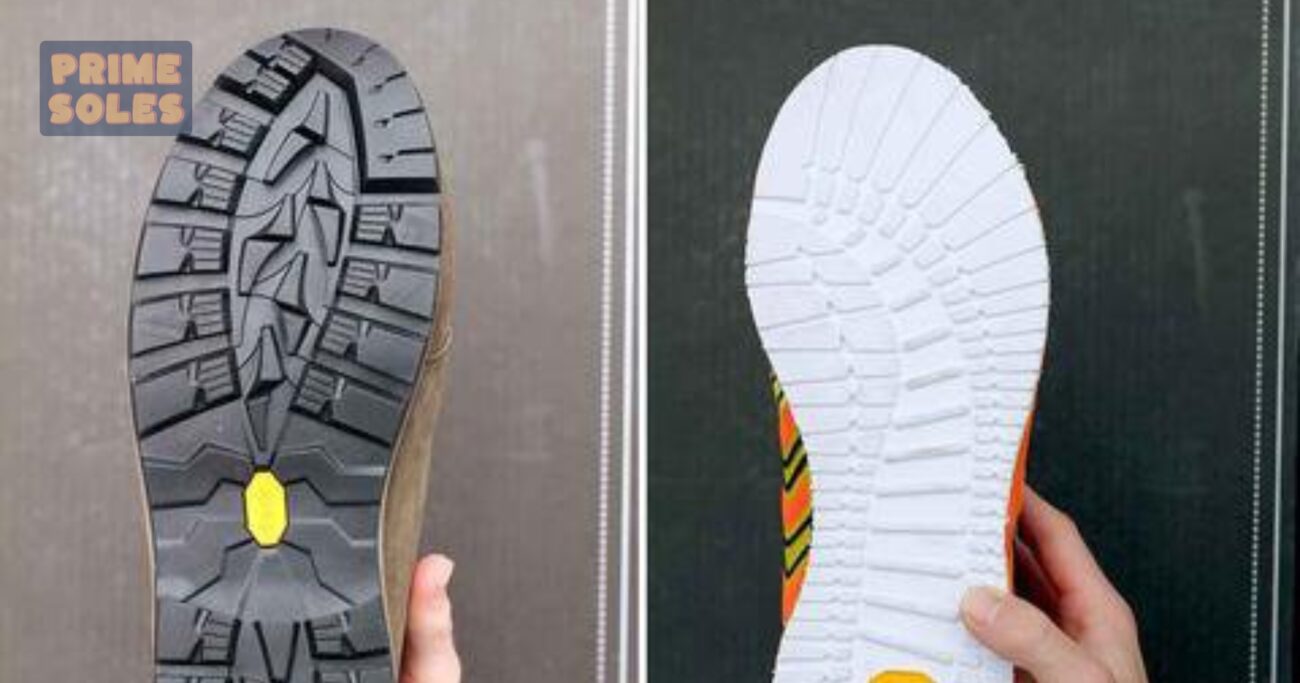
Materials
The material of your shoes will also affect the slip resistance. Natural materials such as leather and suede provide less protection against slipping than synthetic materials like rubber or PVC. For maximum protection, look for shoes made of non-slip materials such as rubber, neoprene, or synthetic leather.

Design
The design of the shoe is also crucial for ensuring non-slip protection. Look for shoes with a low center of gravity, as this will help to reduce the risk of slipping. Shoes with laces or Velcro straps are also better at providing an extra layer of security on slippery surfaces.

Use Ice Grips
Ice grips are a great way to provide extra grip on slippery surfaces. These are unique rubberized soles designed to give you extra traction on icy or wet surfaces. If your shoes don’t have ice grips, many aftermarket products can be easily applied over the existing sole.
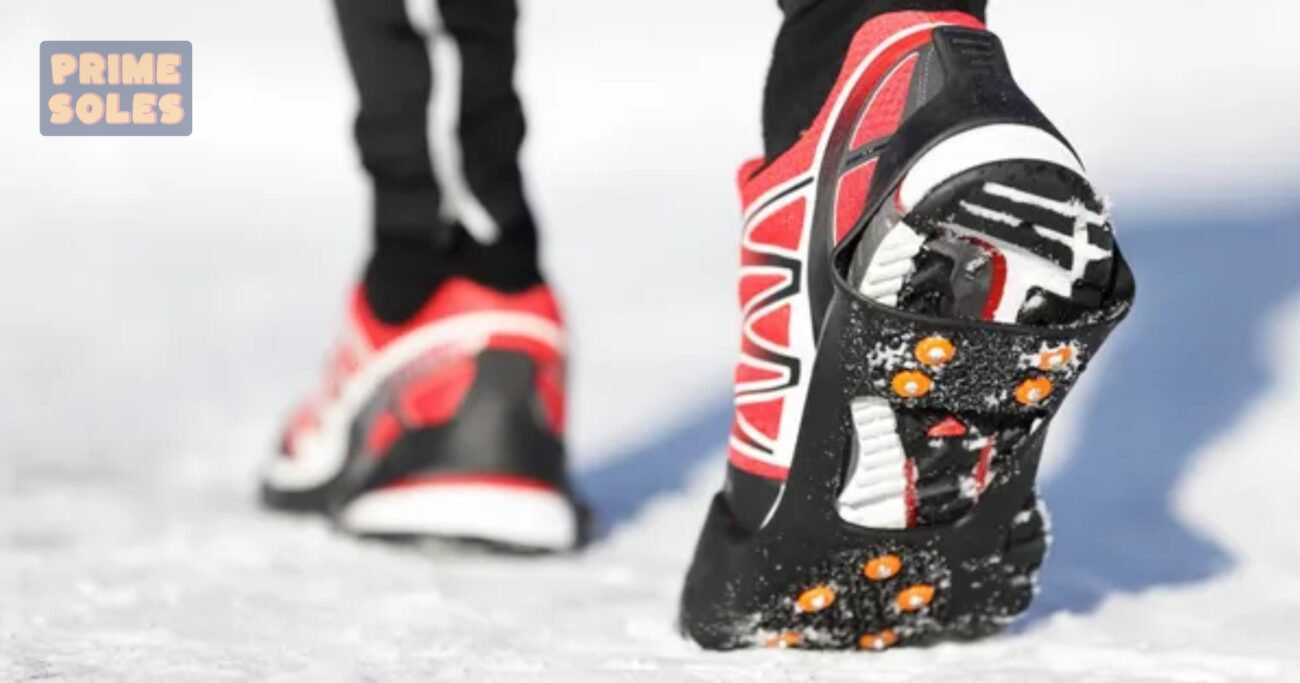
Add a Mixture of Rubber Glue and Salt
This is an easy way to improve any shoe grip on slippery surfaces. All you need to do is mix equal parts rubber glue and salt, then spread the mixture onto your shoes’ soles. The combination will create a rough surface that improves traction and grip.

Spray Hairspray on Your Outsoles
Spraying your shoes with hairspray can also help to improve their slip resistance. The alcohol in the hairspray will create a rough surface that will increase traction on slippery surfaces. Just spray it evenly over the outsoles of your shoes and let it dry – you’ll be ready to go in no time!

Make Grooves in Your Soles
If your shoes don’t have any pattern or texture on their soles, you can still make them slip-resistant. Take a knife or sharp object and create shallow grooves in the sole of your shoes. This will create a rougher surface, giving you better grip and traction on slippery surfaces.
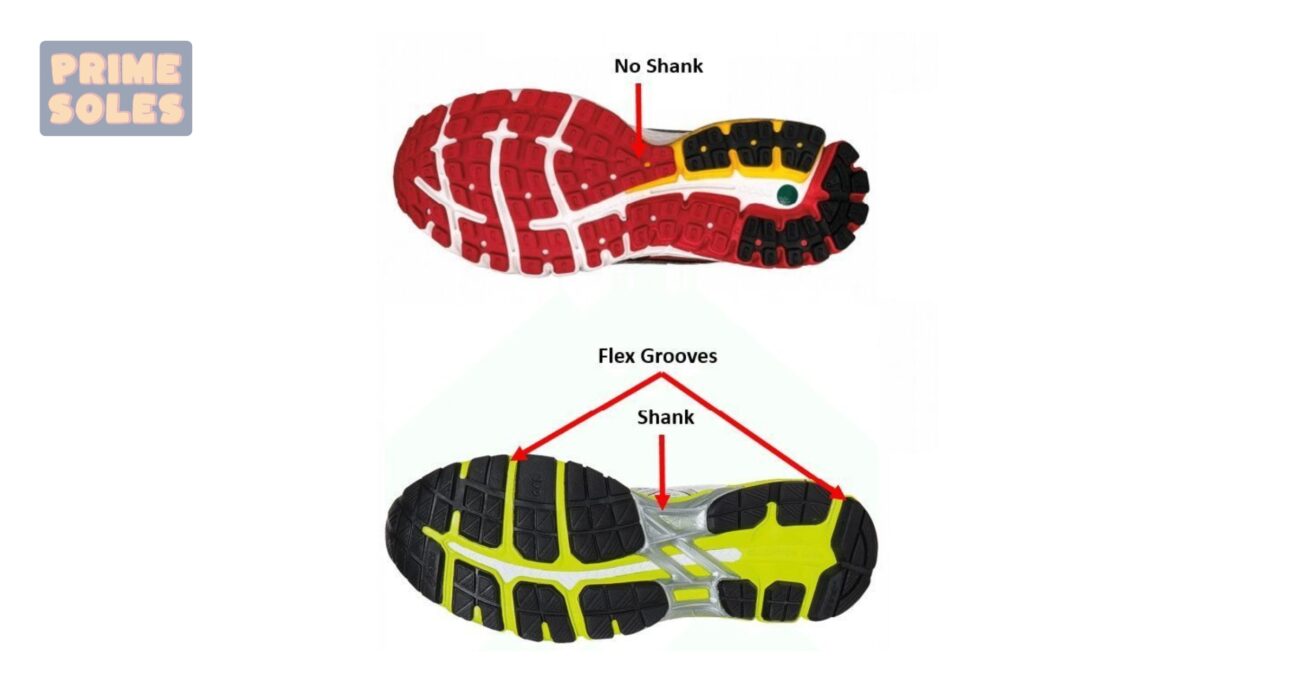
Rub your Shoes with Sandpaper
If other trick fails, you can also try rubbing your shoes with Sandpaper to make them slip-resistant. Just be sure to rub lightly, as too much pressure can damage the sole of your shoes. Once you’ve rubbed down your soles, they’ll be ready to provide extra grip and protection on slippery surfaces.

Re-Sole Your Shoes
If none of these methods are improving the slip resistance of your shoes, you may need to re-sole them. This involves replacing the existing sole with a thicker one that is more slip-resistant. You can either do this yourself or take your shoes to a cobbler who can professionally re-sole them.

No matter what terrain you’re exploring, it always pays to have non-slip shoes. With the proper knowledge and a few simple steps, you can ensure your shoes are up to snuff regarding grip and protection. Take some time to assess the features of any shoe before you buy it, and be sure to check for its slip resistance either by using one of the methods discussed above or taking it for a test walk on a slippery surface. Follow our tips, and your feet will stay safe no matter where life takes you.
Advantages of Slip-Resistant Shoes at Work
Let s take an eye on the advantages of slip-resistant shoes at work.
- Improved Comfort: Non-slip shoes are designed with comfort in mind. They provide extra cushioning and support for your feet, helping to reduce fatigue and discomfort.
- Longer Lasting: Non-slip shoes can last longer than traditional shoes due to their improved grip and protection. This means you will have to replace them less often, saving you money in the long run.
- Helps in Avoiding Accidents: Slip-resistant shoes can help to reduce or minimize the risk of slips and falls, which can lead to severe injuries in the workplace. The extra traction provided by non-slip shoes can make it easier to maintain your balance on slippery surfaces, helping you to avoid accidents.
- Durable: Non-slip shoes are designed to withstand wear and tear, making them more durable than traditional shoes. This means you will have to replace them less often, saving you money in the long run.
- Fulfilling Job Requirements: Many employers now require employees to wear slip resistant shoes for safety reasons. Wearing non-slip shoes can help ensure you comply with the job requirements and stay safe.
- Increases Traction: The unique treads of slip-resistant shoes increase traction, which can help to reduce or minimize the risk of slips and falls in the workplace. This additional grip can make it easier to maintain your balance on slick surfaces.
- Helps in Improving Balance: Slip-resistant shoes provide extra grip and support for your feet, which can help to improve your balance on slippery surfaces. This improved stability can reduce the risk of slips and falls.
Tell me the risk of wearing slippery shoes.
The risk of wearing slippery shoes are listed below.
- Slips and falls: Slippy shoes can lead to slips and falls, which may result in serious injuries.
- Lack of traction: slippery shoes will not provide adequate traction on slippery surfaces, leading to an increased risk of slipping or falling.
- Poor arch support: slippery shoes often lack the necessary arch support for proper foot health, leading to long-term foot and joint issues.
- Lack of cushioning: slippery shoes may not have the necessary cushioning to protect your feet from impact, leading to discomfort and potential injuries.
- Poor grip on surfaces: slippery shoes can make it challenging to get a good grip on slippery surfaces, such as wet floors or ice. This can lead to an increased the danger risk of falling or tripping.
By understanding the risks involved in wearing slippery shoes, you can make sure you take the necessary steps to protect yourself and your feet by choosing a pair of non-slip shoes for your next adventure. Be safe out there!
Video Guide:
What makes shoes non slip?
Conclusion
Non-slip shoes are a must-have if you’re looking to explore the outdoors. They provide extra traction and support, helping you to stay safe and comfortable on slippery surfaces. Keep in mind the critical features of non-slip sneakers, and take your shoes for a test walk before you make your purchase. With this knowledge, you can confidently take on any terrain life throws your way!
FAQs
How can I tell if a shoe is slip-resistant?
Different things tell you if a shoe is slip resistant or not. Look for the tread pattern on the sole of the shoe. The smaller the tread pattern, the more influential the slip resistance. You can also look out for the materials the shoe is made of. Shoes with rubber soles are better at providing grip and traction than leather or fabric soles.
Does rubber sole mean non-slip shoes?
Yes, rubber soles are usually a sign of slip resistance. The tread pattern on the sole should be small enough to provide adequate traction but big enough to allow movement. Non-slip shoes also often feature particular traction patterns, like grooves and ridges, that provide additional grip on slippery surfaces. Make sure to check your shoes’ tread pattern and material before purchasing them to ensure that they are slip-resistant.
What does a non-slip sole look like?
Non-slip soles or slip-resistant soles typically feature hexagons, circles, or other shapes that allow water to escape. This helps to reduce the amount of water that accumulates on the sole, increasing traction in wet conditions. Look for a sole with small hexagons or circles to ensure that your shoes are slip-resistant.

